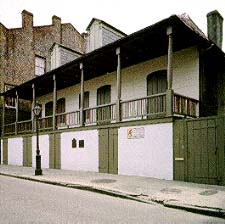|
|
|
|
The Quadroons |
 |
| |
|
|
|
Link 1 |
Link 2 |
Link 3 |
| |
|
|
Link 4 |
Link 5 |
Link 6 |
One of the oldest buildings
in New Orleans bears the strange name Madame
John's Legacy for a fictitious woman of color. Ironically,
that is the only name to survive from a unique group of free
women of color who became mistresses of French men.
Madame John, according
to a story written by George Washington Cable in the 1860s,
was a quadroon, a light-skinned mistress of a French-Creole
man, Monsieur Jean. Upon his death she inherited his estate,
as he had never married a woman of his race. In the story
Madame John (jean) is persuaded to sell the property, but
the bank where she invests the money goes under and she is
left destitute to raise her daughter.
| |
|
|
| |
Excerpts by..... Eleanor Early
The most beautiful woman I ever saw was the colored wife of a Negro diplomat from Haiti, a pale girl with skin like gardenias. I met her at a reception at the President's Palace in Port-au-Prince. Her eyes were the color of Haitian bluebells, which is the shade of delphinium which is a cross between clear blue and purple.
Her mouth was a pomegranate cut in halves, and the wings of her blue-black hair were the wings of a Congo thrush. her maiden names was Dumas, and she was descended from the great Dumas, père and fils. The first Dumas was the son of a French marquis and a colored woman from Santo Domingo. Some of Dumas'sdescendants are white and some are black.
|
|
| |
|
|
| |
A Duke of Saxe-Weimar-Eisenbach
. . . was most favorably impressed by the Quadroons. He visited New Orleans in 1825 and attended a Quadroon Ball where he danced with the girls, and met their mothers.
The duke, who was a brother-in-law of William IV (the uncle of Queen Victoria) said the Quadroons were "the most beautiful women in the world." if Victoria heard that, she probably washed her hands of the duke. . . .
|
|
For several generations,
1790 to 1865, it was not unusual for a young white Creole
man to take a free woman of color as his mistress, set her
up in her own house and have several children with her before
he reached his mid to late twenties and married a French woman
to raise his legitimate family.
This was different from
plantation life throughout the South where it was well known
that some white masters consorted with their female slaves.
Those relationships were not openly recognized, and children
born of such liaisons were considered black and slaves, taking
their status from their mothers.
In New Orleans placage, the
local term for open miscegenation, did not involve slave women
but rather free black women who had a limited degree of choice
as to whether they were to become a mistress and whose mistress
they would be.
The relationship was
often a long-lasting one, sometimes continuing long after
the man married. Children born in placage generally took their
white father's last name, were supported by him, and even
in some cases indirectly inherited large sums upon his death.
Daughters were often raised to become mistresses of the next
generation of white Creole men, while sons were sometimes
sent to Paris to be educated, as there were few schools for
such children in New Orleans.
 |
Unfortunately no exact
history of this placage system exists. It is not know how
many such liaisons took place, how many men supported their
families of color, nor how many men like Monsieur Jean never
married. Quadroons were known to be loyal to their white lovers.
If a man deserted his family of color, the quadroon often
had to work to support herself and her children . Professions
such as hairdresser, seamstress, and shopkeeper were often
practiced by such women; other times they opened their homes
as guesthouses. Later on American men and planters from upriver
also kept quadroon mistresses in New Orleans.
The origin
of the placage system is uncertain. The custom may have been
imported early on by French and Spanish settlers from Santo
Domingo and the West Indies where it was practised widely.
Another factor would have been the scarcity of marriageable
white women for the Creole men, and conversely of available
free men of color for free black women to marry. This imbalance
lasted up to the Civil War. The majority of free blacks were
apparently women; a census of the city in the late 1700s married
women of color numbered fifteen hundred.
|
|
 |
 |
|

